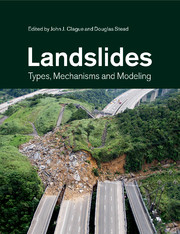Book contents
- Landslides
- Landslides
- Copyright page
- Contents
- Contributors
- Preface
- 1 Landslide hazard and risk
- 2 Landslides in the Earth system
- 3 Earthquake ground motion and patterns of seismically induced landsliding
- 4 Landslides at stratovolcanoes initiated by volcanic unrest
- 5 Mobility of long-runout rock avalanches
- 6 Rapid rock-slope failures
- 7 Risk assessments for debris flows
- 8 Landslides in quick clay
- 9 Controls on the distribution of major types of submarine landslides
- 10 Tsunami hazard assessment related to slope failures in coastal waters
- 11 Physical impacts of climate change on landslide occurrence and related adaptation
- 12 Landslides and geologic environments
- 13 Numerical modeling of rock-slope instability
- 14 Remote sensing techniques and landslides
- 15 Engineering geomorphology of landslides
- 16 Developments in landslide runout prediction
- 17 Models of the triggering of landslides during earthquakes
- 18 Slow rock-slope deformation
- 19 Landslide monitoring:
- 20 Groundwater in slopes
- 21 Soil slope stabilization
- 22 Rockfall characterization and modeling
- 23 The 2006 Eiger rockslide, European Alps
- 24 Randa:
- 25 Characterization and management of rockslide hazard at Turtle Mountain, Alberta, Canada
- 26 The Åknes rockslide, Norway
- 27 A seismometric approach for back-analyzing an unusual rockfall in the Apennines of Italy
- 28 Downie Slide, British Columbia, Canada
- 29 The 1963 Vaiont landslide, Italy
- 30 Hong Kong landslides
- 31 Landslides induced by the Wenchuan earthquake
- 32 Landslides on other planets
- Index
23 - The 2006 Eiger rockslide, European Alps
Published online by Cambridge University Press: 05 May 2013
- Landslides
- Landslides
- Copyright page
- Contents
- Contributors
- Preface
- 1 Landslide hazard and risk
- 2 Landslides in the Earth system
- 3 Earthquake ground motion and patterns of seismically induced landsliding
- 4 Landslides at stratovolcanoes initiated by volcanic unrest
- 5 Mobility of long-runout rock avalanches
- 6 Rapid rock-slope failures
- 7 Risk assessments for debris flows
- 8 Landslides in quick clay
- 9 Controls on the distribution of major types of submarine landslides
- 10 Tsunami hazard assessment related to slope failures in coastal waters
- 11 Physical impacts of climate change on landslide occurrence and related adaptation
- 12 Landslides and geologic environments
- 13 Numerical modeling of rock-slope instability
- 14 Remote sensing techniques and landslides
- 15 Engineering geomorphology of landslides
- 16 Developments in landslide runout prediction
- 17 Models of the triggering of landslides during earthquakes
- 18 Slow rock-slope deformation
- 19 Landslide monitoring:
- 20 Groundwater in slopes
- 21 Soil slope stabilization
- 22 Rockfall characterization and modeling
- 23 The 2006 Eiger rockslide, European Alps
- 24 Randa:
- 25 Characterization and management of rockslide hazard at Turtle Mountain, Alberta, Canada
- 26 The Åknes rockslide, Norway
- 27 A seismometric approach for back-analyzing an unusual rockfall in the Apennines of Italy
- 28 Downie Slide, British Columbia, Canada
- 29 The 1963 Vaiont landslide, Italy
- 30 Hong Kong landslides
- 31 Landslides induced by the Wenchuan earthquake
- 32 Landslides on other planets
- Index
Summary
In July 2006, approximately 2 million m3 of massive limestone began to move on the east flank of the Eiger in central Switzerland. For more than two years after the initial failure, the rock mass moved at rates of up to 70 cm per day. A detailed analysis of the structures and velocities of the different moving blocks was conducted with the aid of terrestrial laser scanning. The moving rock mass included a rear block that subsided, pushing a frontal block forward. Movement directions were controlled by discontinuity sets that formed wedges bounded on one side by sub-vertical bedding planes. The instability was, until recently, buttressed by a glacier. Slope observations and results of continuum and discontinuum modeling indicate that the structure of the rock mass and topography were the main causes of the instability. Progressive weathering and mechanical fatigue of the rock mass appear to have led to the failure. A dynamic analytical model further indicates that the rockslide was primarily controlled by a reduction in the strength of discontinuities, the effects of ice deformation, and – to a limited extent – groundwater flow. This study shows that realistic and simple instability models can be constructed for rock-slope failures if high-resolution data are available.
- Type
- Chapter
- Information
- LandslidesTypes, Mechanisms and Modeling, pp. 282 - 296Publisher: Cambridge University PressPrint publication year: 2012
- 9
- Cited by

